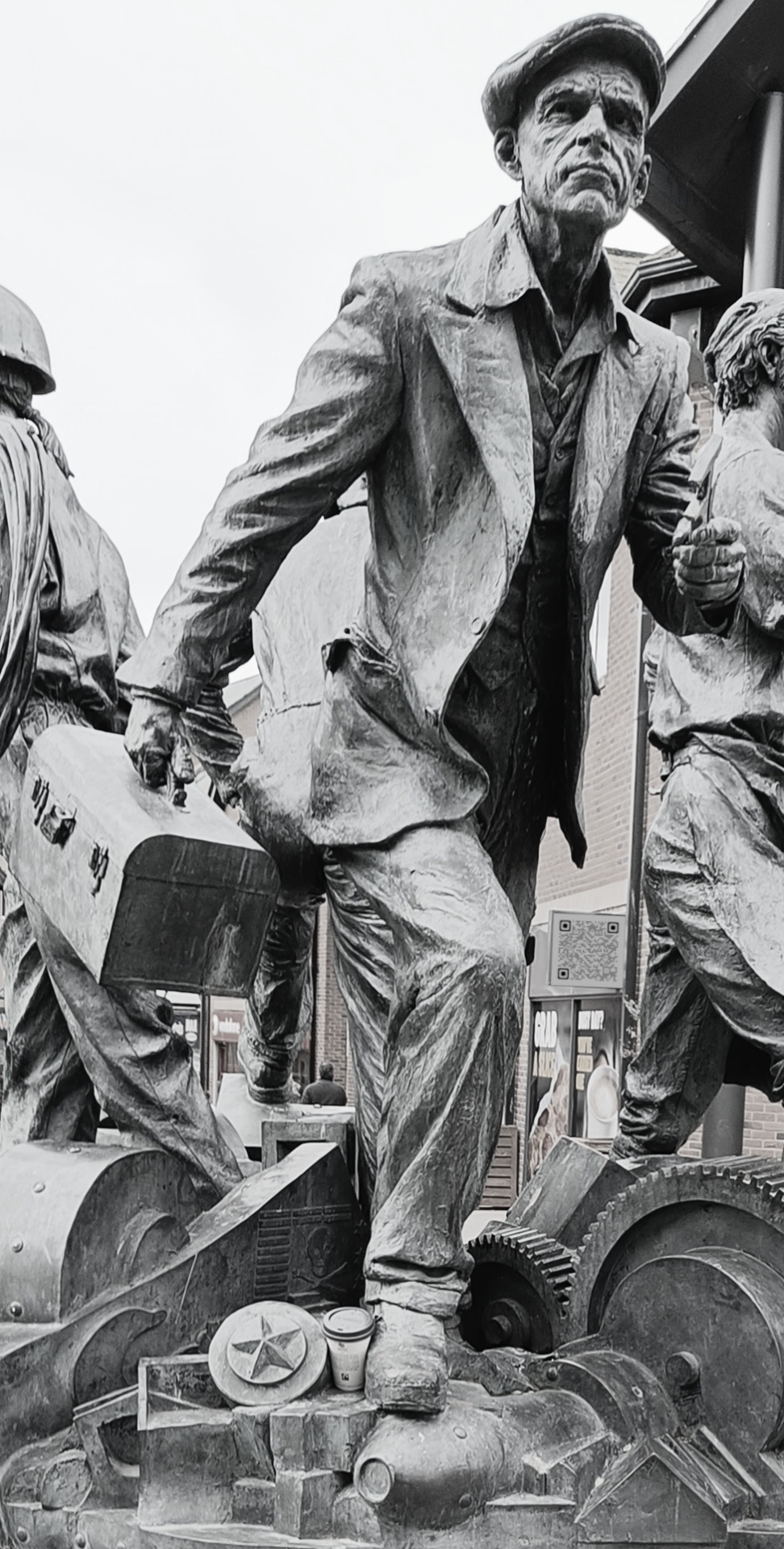#barrow in furness
Text
The Vicarstown Car Ferry

Above: This is not the Vicarstown car ferry train. I just needed a screenshot of a car on a train, and this was the closest I had to hand.
Every year, the Island of Sodor receives thousands of visitors from the Mainland, and obviously, the vast majority come by rail. A significant number, however, choose to arrive by car. Nowadays, this is no trouble, as they can simply drive across the Jubilee Bridge, which carries the main A950 road over the Walney Channel.
The bridge only opened in 1977, though, and any motorists arriving before then had to rely on the NWR's services to get themselves and their cars on and off of Sodor. And thereby hangs a fascinating tale about a little-known aspect of the NWR's history.
EARLY NWR EFFORTS
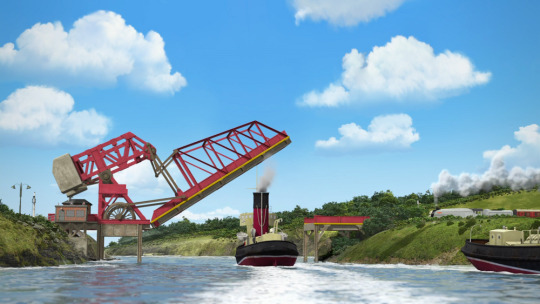
Above: The Vicarstown Bridge, in an undated view (obviously post-1975, given the presence of Spencer).
It all started with the construction of the NWR's own bridge over the Channel in 1915. In those days, there was no other link between Sodor and the Mainland, and thus no other way for goods and passengers to arrive. Some of those passengers wanted to bring their own horse-drawn carriages with them, and so was born one of the earliest vehicle-and-owner trains to run on Sodor.
To begin with, it was simply a case of strapping the vehicle to a special carriage truck, and coupling it up to whatever passenger train its owner was travelling in. The truck then travelled as far as the nearest station to wherever the owner was going, where it was detached and the vehicle rolled off.

Above: For a time, the NWR also offered the use of a horsebox in conjunction with a carriage truck, so that the carriage’s owner could take his own horse with him, and avoid having to search for one at the other end of his journey. This cost extra, though, so there were few takers.
THE VICARSTOWN CAR FERRY
With the boom of private motoring in the early-1920s, there came a similar explosion in demand for the carriage of road vehicles by rail. This in turn resulted in the NWR running its first dedicated car-carrying trains - albeit only on an as-and-when basis, and with cars and drivers travelling in separate trains. The NWR did not return to vehicle-and-owner trains until 1927, when it launched a regular car ferry service between Vicarstown and Barrow-in-Furness - probably the best-known of all its car-carrying trains.
This new service had been made possible by the 1925 LMS Agreement, which gave the NWR running powers into Barrow, and in turn required Vicarstown to be converted for through running. Among the changes which resulted was the conversion of the adjoining goods depot to handle parcels and mail (goods facilities moving to a new depot elsewhere), and the closure of the existing parcels platform. This platform was thus free for conversion into a loading dock for the new car ferry service.
OPERATIONS
Throughout the fifty years the car ferry service ran, the basic pattern of its operation remained much the same, with only details like the motive power, rolling stock and timings seeing much change. It is thus worth looking at a typical journey for the service, starting at Vicarstown and ending at Barrow.
Below: A vague representation of how the loading process would have looked. I've employed a bit of artistic license with this photo: while the NWR did have some enclosed double-decker car carriers, these were never used on the car ferry services.

To begin with, the consist for that particular crossing was shunted into the station - the carriage trucks going to the loading dock, and the passenger coaches to one of the through platforms. Drivers and passengers boarded their coaches, leaving their cars to be loaded by the station staff. Once loading was completed, the carriage trucks were marshalled and coupled to the coaches. All shunting was done by the train engine, who then ran round to the front and hauled the train to Barrow. On arrival, the whole train was shunted to the loading dock there, where passengers and cars were unloaded together. The stock was then taken away for servicing.
Of course, it goes without saying that in the opposite direction, the whole procedure was repeated, only in reverse.
In all, ten car ferry trains ran daily (five in each direction), with provisions in the working timetable for an extra four (two in each direction) if they were needed - say, during the busier summer months. To avoid overcrowding, a maximum of 20 cars were allowed on each crossing, and motorists had to book in advance. This enabled staff to work out how many carriage trucks were required, and what types, well ahead of time. It also allowed them to work out how many passenger coaches were needed - the rule here was that there should be at least one compartment for every car carried.
In the early 1930s, the NWR began allowing larger commercial vehicles to make use of the car ferry trains, and this required a slight amendment to the 20 cars rule. This amendment counted the size of a vehicle in car lengths - if, for example, a lorry turned up which was as long as three cars, then it took up three slots on that particular crossing. Any number of vehicles could thus travel on a single train, so long as their total length did not exceed 20 car lengths.
STOCK
The car ferry trains never had a specific engine allocated to run them - generally, any engine could do the job if they happened to be at Vicarstown or Barrow at the right time. As the NWR’s locomotive roster expanded, the car ferry became the exclusive preserve of the engines based at either of those sheds - the job generally being allocated to any engine who wasn't busy anywhere else that day.
The car ferry was also a neat way of getting an engine from one station to the other, without having to find an extra path for a light engine movement. For similar reasons, it was not uncommon for visiting LMS (later BR) engines to take charge of a Barrow-bound car ferry on their way home.
Below: An example of a long-wheelbase covered carriage truck. Many were later converted for parcels, newspapers or general goods traffic. This particular example went into departmental service, and in this view is carrying engine parts.

As far as rolling stock was concerned, this mainly consisted of both open and covered carriage trucks (henceforth referred to as OCTs and CCTs respectively). When the service first started, cars were carried on short-wheelbase OCTs, but these proved unpopular with motorists, as the cars often had their paintwork spoiled by smoke and soot spewing from passing engines - and sometimes from the engine pulling the train! The NWR tried to remedy this by offering the use of protective tarpaulins, but eventually they decided it would be more prudent to switch to CCTs instead.
Single cars were carried in short-wheelbase vans, similar in design to the GWR’s Mogo vans.
For pairs of cars, longer wheelbase CCTs could be used.
For trios or quartets, bogie CCTs were employed.
When larger commercial vehicles began to be carried, bogie OCTs were used - converted from the underframes of the fabled Dublin Stock.
Because of the aforementioned one compartment for every vehicle rule, the passenger coaches were at first quite a motley collection, with the numbers being made up by any old stock just lying around. It was only from the 1930s onwards that more consistent rakes of coaches began to be used - starting with Ironclad-pattern stock, moving on to Maunsell-pattern just after the War, and finishing up with Bulleid-pattern in the BR era.
MOTORAIL
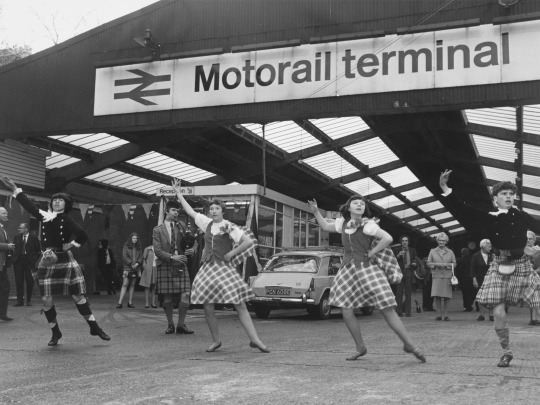
Above: A display of Scottish country dancing at...I think it's Kensington Olympia? No, I don't know why either.
In the 1960s, British Rail officially launched its Motorail service, offering fast travel for passengers and their cars to all parts of the country. To serve Sodor, one of the new services ran twice daily between Kensington Olympia and Vicarstown, and the latter’s existing loading dock was upgraded into a terminal. Two of the car ferry's ten daily crossings clashed with the proposed timings of the new Motorail services, and so were slashed from the timetable. Other than that, the car ferry was able to carry on as normal.
By then, the rolling stock used for the car ferry was beginning to show its age, and a programme of gradual replacement was implemented from about 1966 onwards:
For cars, General Utility Vans replaced the old bogie CCTs, which were retained for parcels traffic.
For commercial vehicles, Carflats replaced the OCTs, which were either scrapped or placed into departmental service.
Finally, for passengers, some of the NWR’s own allocation of BR Mk1s replaced the Bulleid-pattern stock.
The car ferry trains continued unabated into the 1970s, but it was clear they were running on borrowed time - for the first time, demand was beginning to outstrip capacity, and there was no room in the timetable to run extra trains. Then, exactly fifty years after the car ferries had first began, came a blow from which they were never to recover.
THE JUBILEE BRIDGE
That year saw the opening of the Walney Road Bridge, to mark the Silver Jubilee of Queen Elizabeth II. Needless to say, this snuffed out the NWR's car ferry monopoly in an instant. Nobody was more incensed at this development than Sir Topham Hatt, and he saw to it that the NWR was substantially compensated for the extinguishment of their ferry rights.

Above: The Jubilee Bridge. Visitors to Barrow (and native Barrovians, too) may think that this is the only bridge here. This is an illusion!
All was not totally lost, however, for 1977 also saw the extension of BR's existing London-Vicarstown Motorail service to a brand new terminal at Killdane - a more convenient base for the visiting motorist to explore Sodor. Such was the success of this new service that further others were introduced, linking Sodor with other provincial centres. Some of these services employed the stock which had previously worked the car ferry trains.
MODERN DAY MOTORAIL
The expansion of Sodor's Motorail services came during a period of gradual decline for the brand across the rest of BR. The expansion of Britain's motorways, the improvement of car technology, and the chaos of privatisation all ultimately conspired to kill off Motorail by the early-1990s.
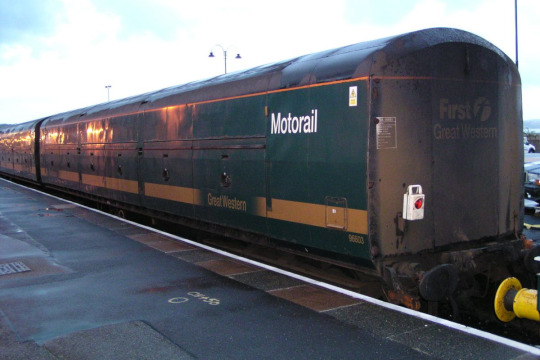
Above: First Great Western briefly revived the Motorail concept in the early-2000s, using a fleet of converted GUVs.
Despite this, Motorail on Sodor has continued to flourish into the present day. Not only are its existing terminals at Vicarstown and Killdane still in operation, but there is now a third terminal at Tidmouth. These form the basis for the NWR's current Motorail services, which all serve to help solve a very basic problem.
The thing is, many visitors to Sodor now arrive in their own cars, but the island's road transport infrastructure isn't really suited to the needs of the long-distance motorist. Fortunately, the NWR has them covered. Special car-carrying trains now run regularly between the Motorail terminals at Vicarstown, Killdane and Tidmouth. While you still have to book in advance, it's a small price to pay for having the convenience of a car at your disposal, without the insanity that comes from having to drive it all the way across Sodor.
Of course, while the NWR's Motorail trains are available to all motorists (local and foreign) the majority of their customers are Mainlanders - the typical Sudrian would just as soon leave his car at home altogether!
#thomas the tank engine#the railway series#sodor#island of sodor#ttte headcanon#ttte analysis#north western railway#vicarstown#vicarstown bridge#barrow in furness#car ferry
42 notes
·
View notes
Text
Strike Walk #4
All around Barrow-in-Furness
Career of Evil chapters 24-27
This is Part Five, there's a link to earlier parts at the end.
Although they can see her through the glass door of The Bakery, Strike and Robin decide not to try to speak to Holly Brockbank at her place of work, but to try and catch her later at the pub. Strike mourns the pie he could have bought was it not for Labor Omnia Vincit, but I'm on holiday so I had a nice chat with the owner in her new premises and bought a meat and potato.
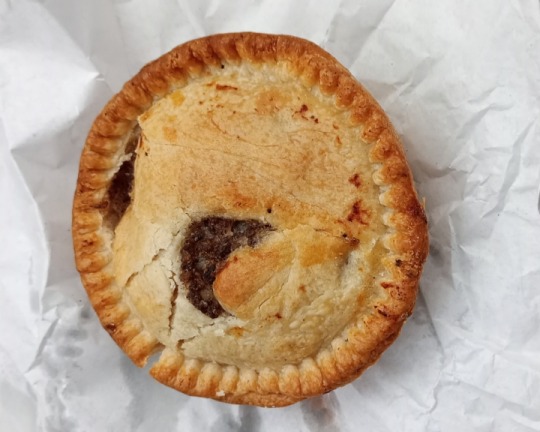
Strike follows Holly while Robin drives to a deserted stretch of road by a marshy wasteland (take your pick) changes out of her jeans and acquires some fake business cards at an unspecified shopping centre.

They meet at The Crow's Nest - "a large, drum-shaped building of red brick" which stands "where Ferry and Stanley Roads met and formed a hairpin bend".

Robin goes in as Venetia Hall and, as we know, aces it. I was a bit nervous of going in because it looked like a locals place, but it was the nicest pub and the best pint of lager I have had in years. If you're on your own take some cash though because there's a minumum spend on a card. I had to buy two packets of crisps and a Starbar.
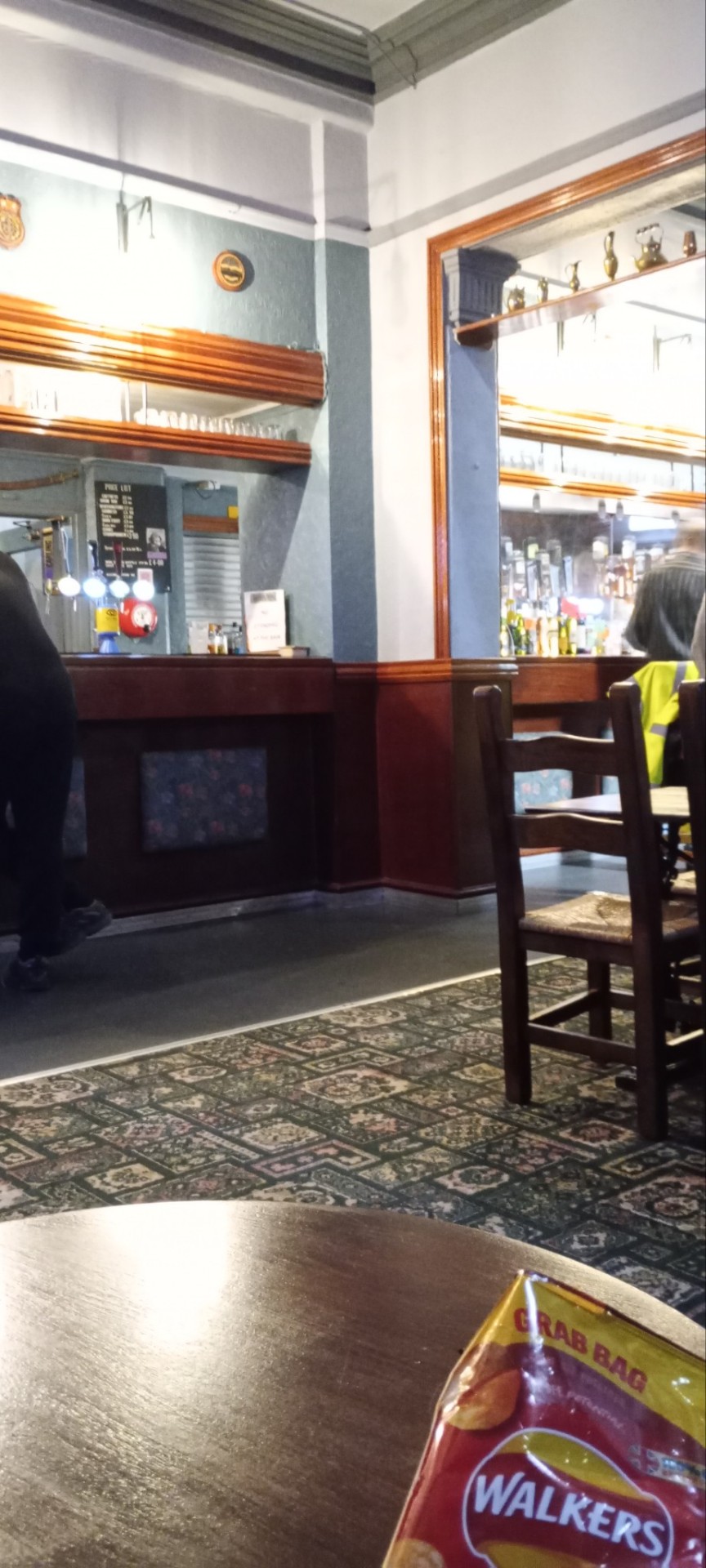
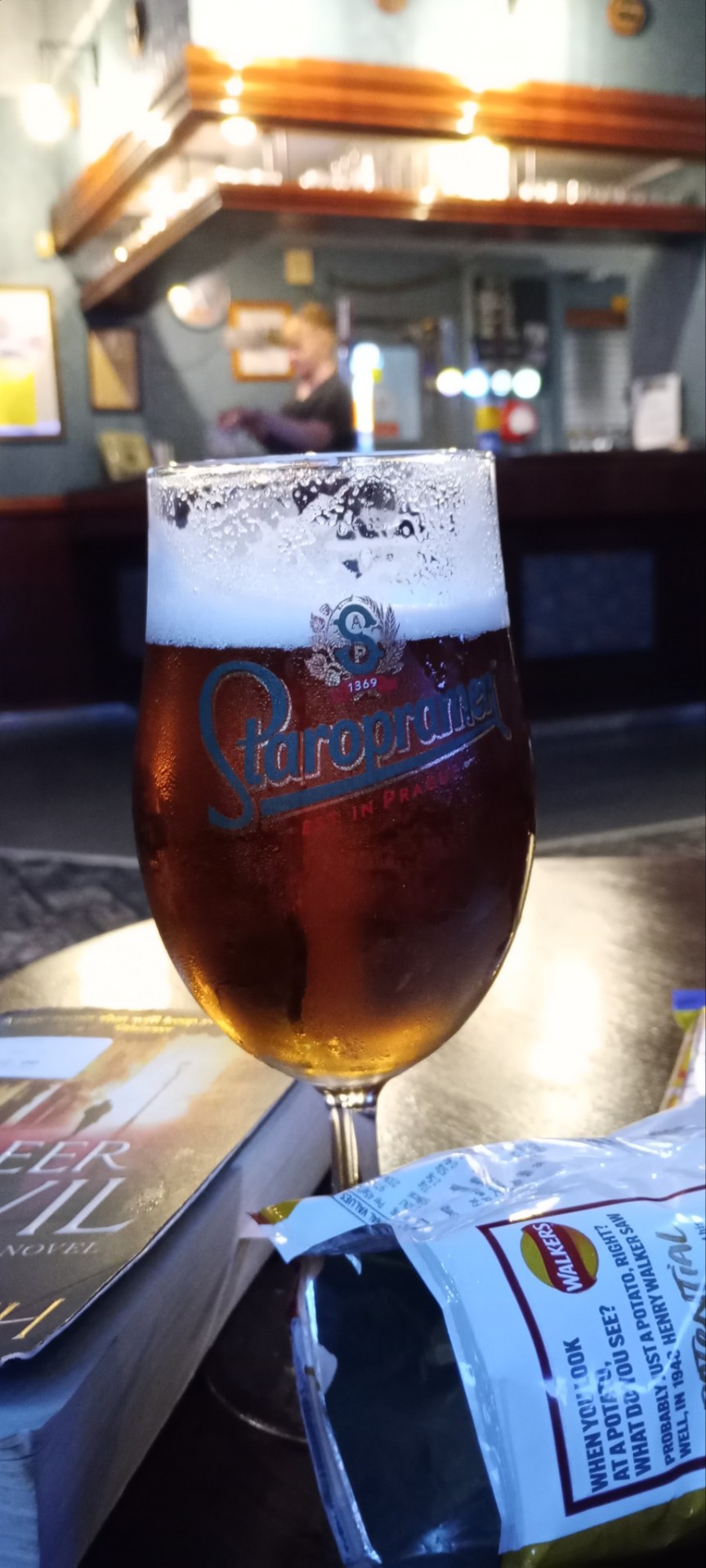
After the triumph Strike and Robin celebrate with fish and chips from the Olympic Takeaway, eaten in the Landy. The Olympic's "bright windows intensified the surrounding darkness."

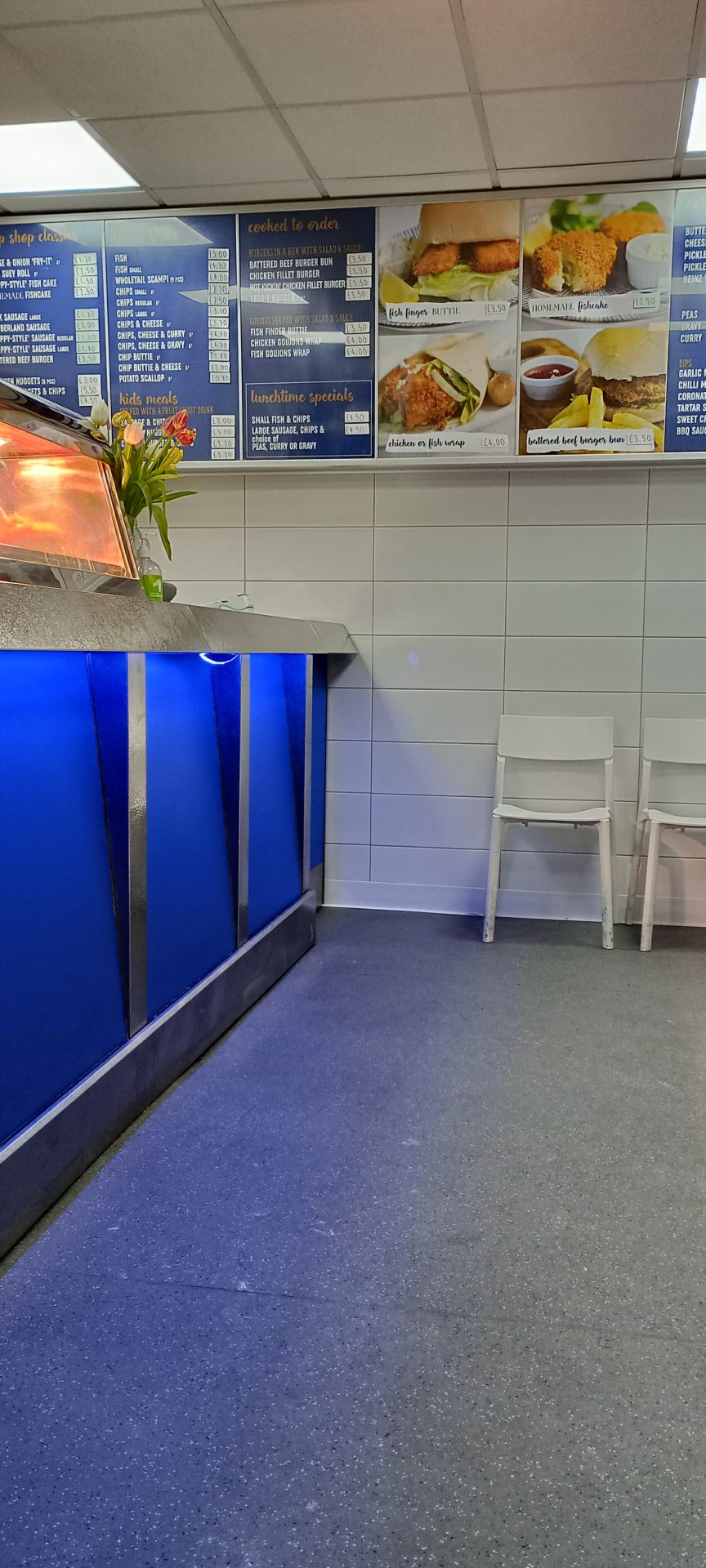
After being serenaded by old Barrovians (no-one serenaded me, sadly) they check into the Travelodge, where they are placed upstairs, five rooms apart.

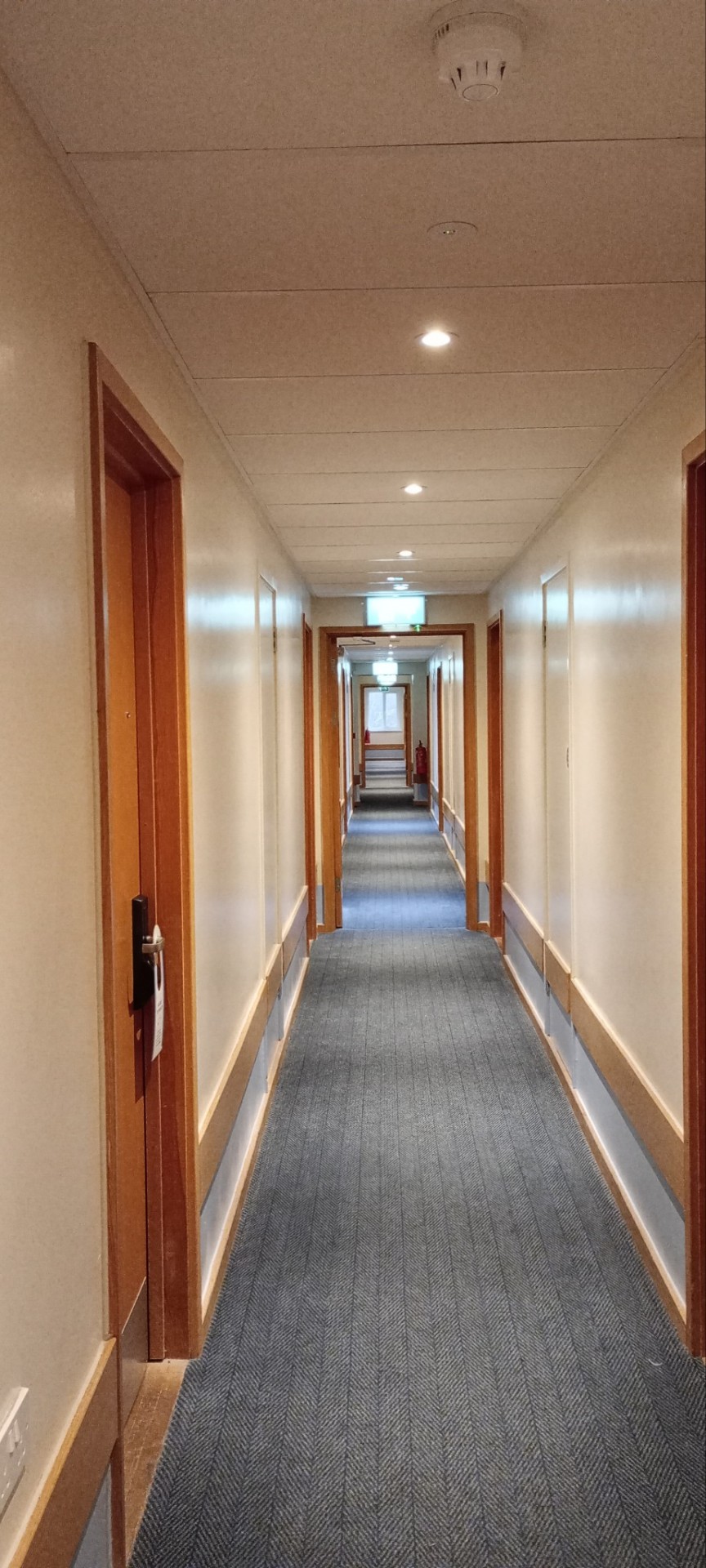
Robin, unsettled and self-conscious, opens her window, and notes that the view is of the same industrial warehouses they passed at the start of their visit. I don't know how she'd see that in the dark - I had to wait until the morning after to see anything.

Footnote: there's no restaurant at the Barrow-in-Furness Travelodge, so Strike can't have filched pastries and Robin can't have filled their flask from the urn in the morning. Personally I feel they shouldn't give planning permission to budget hotels with no breakfast buffet. 😁
That's the end of Strike Walk #4, thanks for reading!
Go back to Part 4
Go back to the beginning:
8 notes
·
View notes
Text
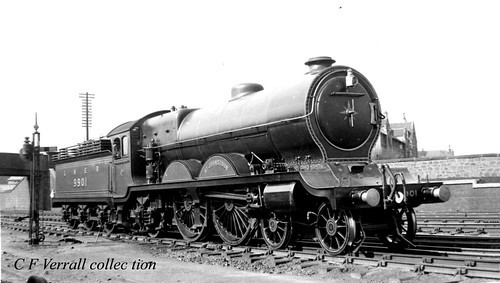
NWC 7: Finally! An Atlantic!
Written By NorthBritishAtlantic
1929
An engine coasted down the Cumbrian Coast Line along the West Coast of England. He seemed to move majestically, his motion hardly making any sound. Like a phantom in the mid morning sun.
As he passed through smaller stations with names such as “Parton”, “St Bees” & “Seascale”, he noticed people on the platform & even some engines looking on at him in awe & surprise.
For you see. This engine was very far from home. For he was a North British Atlantic.
And he had said goodbye to Scotland, for a new life on a small Island, which many people said was in the middle of Nowhere.
Soon, he arrived at a large looking station. Its overall roof covering its platforms. He saw a sign which read “BARROW CENTRAL”, in big bold letters. He pulled up to the platform & his crew got out of his cab.
“We’ll be back in a few minutes Sam.” His driver said.
“Don’t wander off now!” His fireman added, before the driver slapped his arm. Which made Sam chuckle.
The two humans left their Atlantic with his thoughts. He looked around his surroundings. It was a quiet Sunday morning, and there weren't any trains due for an hour or two. So he had the station all to himself.
Or so he thought.
“HEY!” A voice called from behind, causing the Atlantic to jump. “What you doing in my platform?”, “Sitting there like Lord Mutt.” “I’ve got a station to run ya know?!”
Sam looked to his right. Sitting on the track next to him, was a tank engine. Her black paint was bright but dirty. And the letters “LMS'' were in big bold yellow lettering on her sidetanks.
“Well?” She said, eyeing up the larger engine. “Do you say anything?”, “Or do you just sit around & look like an idiot?”
“That’s enough Poppet.” An older voice called. “Leave Him be, even if he is sitting on the mainline taking up space.”
Sam looked over to his left. He saw an older looking engine sitting inside a glass box next to the platform. He had 4 small wheels, a tall thin funnel, and most notably, he had a large round copper firebox.
“The name’s Sam.” The Atlantic spoke, “And you two are?”
“I’m Coppernob”, the old engine said, “And the tank engine next to you is Poppet.”
“What’s an LNER engine doing all the way down here?” asked Poppet, raising an eyebrow at Sam.
“Heading to Sodor”, Sam replied, “NWR needs an engine for local passenger work. So I’m going there to stay.”
“Why you staying?”, Asked Poppet curiously. “Wouldn’t your frien-”
“If I stay I'll end up scrapped.” replied Sam bluntly, cutting Poppet off mind sentence. “My class is on the way out, it's only a matter of time before I’m withdrawn.”
“Don’t worry about it mate.” Poppet said, understandingly. “I’m on borrowed time myself.” “Most of the older Furness engines are being withdrawn as of late.”
“But you at least still have work.” Said Coppernob, “A hard working engine is a useful one.”
Sam sighed. Thank you Coppernob, he smiled slightly.
Poppet chuckled. "Just call him Nobby!" "Everyone else does!"
Coppernob rolled his eyes. Poppet just laughed, and Sam smirked.
“Alright then! Nobby it is!” Sam chuckled.
“So Sam.” Coppernob asked, making the other two stop chuckling. His facial expression was blank. “Have you travelled far?”
“Aye, a wee bit.” Sam said, his gaze returning to the older engine. “Perth, you heard of it?”
“Perth?” Poppet said, raising an eyebrow. “Isn’t that a part of Glasgow?”
The look that Sam threw at Poppet made her shut up instantly & made Coppernob burst out laughing.
The three engines would continue to talk for about 15 more minutes. Nobby & Poppet were telling Sam about one of the old FR’s busiest & most interesting tourist days back in the spring of 1919.
Just as Coppernob was telling Sam about his rather, as he put it, “interesting” experience with a young fireman. Sam’s crew arrived back & came up to see him.”
“Awwww Sam!” His Driver chuckled, putting her jacket back on. “Looks like you made some friends already!”
“Yeah, good on you lad.” His fireman added, trying to hide the obvious lipstick marks on his neck.
“Well come on then!” His driver said, climbing into his cab. “Sodor awaits us!”
“Well goodbye you two.” Said Sam, “I’ll try & visit as much as i can.” “If this all works out that is!” He added chuckling.
“Bye Sam!” “See you around!” Poppet called as Sam drove off.
Sam blew his whistle loudly in goodbye. It echoed around the yard, and startled some of the engines in the shed! He picked up some speed, as he chuffed over the bridge to await his new life.
On the isle of Nowhere.
30 Minutes later
“FINALLY!” a stout gentleman nearly yelled from the platform. “FINALLY I GOT AN ATLANTIC!”
Special thanks to @mean-scarlet-deceiver for letting me use Nobby & Poppet for this story.
#thomas the tank engine#alternate universe#ttte oc#the railway series#thomas & friends#63a#nwc#thomas and friends#trains#other person's oc#NWC: Sam#Coppernob#Barrow In Furness#ttte sir topham hatt
14 notes
·
View notes
Text
Becky Fury's Identity: Putting the -ish in British, death and winning the FA Cup...
Becky Fury at Soho Theatre last week…
Last week, Becky Fury organised a celebratory ‘living wake’ – a ‘woke wake’ – for her ‘mentor’ British Alternative Comedy pioneer Tony Allen. He is still alive.
Among the many performers were Attila The Stockbroker, Bob Boyton, Ivor Dembina, Jonny Fluffypunk, John Hegley, Mark ‘Mr Nasty’ Kelly, Simon Munnery and Alexei Sayle with a bar tab donation by Ben…

View On WordPress
#Barbie movie#Barrow in Furness#Becky Fury#british#comedy#Dead Dad moment#edinburgh fringe#FA Cup#identity#Leytonstone#Lima#racial#racism#Tony Allen#Upton Park#Violet Fury#West Ham#woke wake
0 notes
Text

Downton animal doodles pt 2
#more!#Horay I did something :D#my art#Downton abbey#animal au#anthro#robert crawley#cora crawley#Charles carson#Thomas barrow#Elsie hughes#John Bates#cat#owl#crow#tiger#wolf#safe fur work#corbert#Chelsie#art
200 notes
·
View notes
Note
Does Coppernob know that a Furness Engine that is labeled as preserved is actually buried in a mine? That must be as or more horrifying that being in a glass box.
Look, even in greenhouse days Coppernob has one of the most comfortable possible situations for a superannuated engine. He wouldn't ever claim otherwise.
They all know about poor 115. It was an awful affair. Definitely killed off any remaining vestiges of idealism the Copper-Nobs had about their directors (or THE Director), that's for sure.
That said, the other Furness engines have chosen to believe the company line that 115 is really truly out cold, never again to be conscious. Mainly because there's nothing they can do and the alternative is too horrid to contemplate.
I think it's probable, myself. Just like I believe Duke really did manage to sleep through much of his shed time. Engine sentience eventually goes offline, as it were, when they're unwanted for long enough. A hundred and thirty years will definitely do it.
(The way that F.R. 115 is listed as 'preserved' is so darkly comic, especially in a universe where engines are sapient, that I am sure that Coppernob actually has something to do with this persistent terminology. Like it's a Statement about the implications of all preservation.)
#various furness ocs#furness engines#coppernob#chatter#ttte headcanon#'do not disturb' is a viable & humane approach once a machine is no longer conscious#if you do disturb you better be ready to take full responsibility to restore them to health#if you're not then they're better off as they are#going back to the first paragraph for a mo'#tip for reading bird at barrow central is to note when nobby's situation is objectively bad (which in some respects it is!) (like that is a#and when his mental health is just spiraling down the drain#there's some overlap#but they *are* two separate things
22 notes
·
View notes
Text
Seamless Elegance: Wallpapering Solutions for Barrow's Discerning Clients
youtube
In the world of interior design, the walls of a room serve as a canvas waiting to be transformed into a masterpiece. If you're in Barrow and seeking professional painting and decorating services, look no further than "Painting and Decorating Barrow." Our skilled artisans are here to turn your vision into reality, specializing in wallpapering to elevate your space's aesthetic appeal.
Why Wallpapering?
Wallpapering is a versatile and cost-effective way to breathe new life into any room. It allows for various designs, textures, and patterns, allowing you to express your personality and style. Whether you're aiming for a bold statement or a subtle backdrop, our Painting and Decorating Barrow team has the expertise to handle it all.
Expertise and Experience:
Choosing the right professionals for your wallpapering needs is crucial for a flawless finish. Painting and Decorating Barrow brings a wealth of expertise and experience. Our skilled artisans have successfully transformed numerous spaces, ensuring each project uniquely reflects our client's tastes and preferences.
Quality Materials:
At Painting and Decorating Barrow, we understand that the key to a durable and visually appealing wallpaper is the materials' quality. We source premium wallpapers from trusted suppliers, ensuring that your investment withstands the test of time. Our collection includes many options, from classic patterns to contemporary designs, allowing you to find the perfect match for your space.
Customized Solutions:
Every client has a unique vision for their space, and we take pride in offering customized solutions to bring that vision to life. Whether you want to create a feature wall, add texture to a room, or completely transform the ambience, our team works closely with you to understand your preferences and deliver tailor-made results.
Professional Installation:
While selecting the suitable wallpaper is essential, proper installation is equally critical for a flawless finish. Our team at Painting and Decorating Barrow comprises skilled professionals who are well-versed in the intricacies of wallpaper installation. From surface preparation to precise application, we take care of every detail to ensure a seamless and polished look.
Budget-Friendly Options:
Enhancing the aesthetic appeal of your space shouldn't break the bank. Painting and Decorating Barrow offers budget-friendly wallpapering solutions without compromising on quality. Our transparent pricing and flexible packages cater to various budgets, making our services accessible to everyone looking to transform their living or working space.
Customer Satisfaction:
Our commitment to customer satisfaction is at the heart of what we do. Painting and Decorating Barrow has built a reputation for delivering exceptional service, earning the trust and loyalty of our clients. We take pride in exceeding expectations, and our portfolio showcases the successful transformation of homes and businesses across Barrow.
Conclusion:
If you're in Barrow and dreaming of a space that reflects your style and personality, look no further than "Painting and Decorating Barrow." Our team of skilled artisans is dedicated to bringing your vision to life through expert wallpapering services. Elevate your space with quality materials, customized solutions, and professional installation. Contact us today to embark on a journey of transforming your walls into works of art that stand the test of time.

#Wallpapering Barrow#External Painters Barrow#Domestic Decorating Barrow In Furness#Domestic Decorating Barrow#Painting And Decorating Dalton In Furness#Painting And Decorating Dalton#Residential Decorating Barrow In Furness#Residential Decorating Barrow#Painters And Decorators Barrow#Youtube
2 notes
·
View notes
Photo


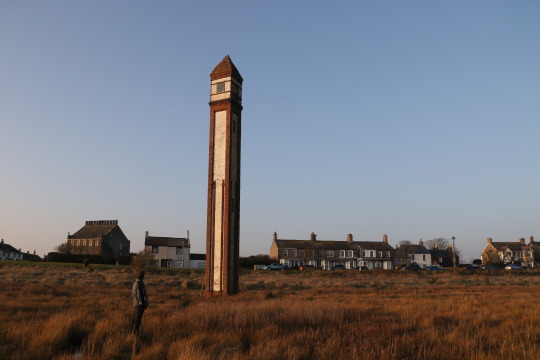


A couple of snaps from today’s lighthouse quest in and around Barrow-in-Furness. Sorry there’s not many - my computer is being a right royal pain today!
Walney Lighthouse, Sir John Barrow Monument, Rampside Leading Light (with bonus views of Piel Island)
10 notes
·
View notes
Photo

Me, furrifying my favorite character from an extremely cringe and bad show because I love him and his shenanigans so much? Never. You got the wrong guy.
#furry art#safe fur work#furry#furrification#sfw furry#furry artwork#my art#furry fandom#anthro#fanart#thomas barrow#downton abbey
21 notes
·
View notes
Text
Find Your Perfect Getaway: Explore Used Static Caravans for Sale in Cumbria
youtube
If you're looking to escape the hustle and bustle of city life and immerse yourself in the serene beauty of Cumbria, owning a static caravan could be the perfect solution. Whether you're seeking a weekend retreat or a long-term getaway, Hanley Caravans offers a wide range of used static caravans for sale in Cumbria. Let's delve into the reasons why purchasing a used static caravan from Hanley Caravans can transform your leisure experience in this stunning region.
Affordable Luxury:
Investing in a used static caravan doesn't mean compromising on comfort or quality. Hanley Caravans takes pride in providing pre-owned static caravans that are meticulously inspected and refurbished to meet the highest standards. By purchasing a used caravan, you can enjoy a luxurious holiday home at a fraction of the price of a brand-new model. Hanley Caravans' extensive collection features various sizes, layouts, and specifications to suit every budget and preference.
Stunning Locations in Cumbria:
Cumbria is renowned for its breathtaking landscapes, picturesque lakes, and charming villages. Imagine having your slice of paradise amidst this stunning region. From the tranquility of the Lake District to the scenic coastal areas, owning a static caravan in Cumbria opens up a world of exploration and adventure. Hanley Caravans offers used static caravans in prime locations, allowing you to immerse yourself in the natural beauty and serenity that Cumbria has to offer.
Flexible Lifestyle:
One of the biggest advantages of owning a static caravan is the flexibility it offers. Unlike a traditional holiday home, you have the freedom to choose when and how often you want to visit your caravan. Whether you're looking for a quick weekend getaway or an extended vacation, your static caravan in Cumbria will always be ready to welcome you. With Hanley Caravans' range of used static caravans, you can find the ideal size and layout to accommodate your lifestyle needs and create lasting memories with family and friends.
Family-Friendly Facilities:
Hanley Caravans understands the importance of family-friendly amenities and facilities. Many of their static caravans are located within holiday parks that offer a range of recreational activities, including swimming pools, playgrounds, sports facilities, and entertainment options. These facilities ensure that everyone, from young children to adults, can enjoy their time in Cumbria to the fullest. Hanley Caravans can guide you in selecting a used static caravan located in a holiday park that suits your family's preferences and interests.
Investment Potential:
Aside from being a delightful holiday retreat, owning a used static caravan in Cumbria can also present an attractive investment opportunity. The region's popularity as a tourist destination ensures a steady stream of potential renters, allowing you to generate income when you're not using your caravan. Hanley Caravans can provide advice and guidance on renting out your static caravan, helping you maximize your investment while also enjoying your own time at this scenic location.
Conclusion: Discover the joy of owning a used static caravan in Cumbria with Hanley Caravans. With their extensive collection of pre-owned models and prime locations, you can find the perfect holiday home tailored to your budget and preferences. Embrace the tranquility and beauty of Cumbria while enjoying the flexibility and comfort of your private retreat. Whether you're seeking a relaxing getaway or an investment opportunity, Hanley Caravans has the expertise and options to make your dreams a reality. Start your journey to a blissful holiday lifestyle in Cumbria today.

#Used Static Caravans For Sale Cumbria#Used Static Caravans For Sale Grange#Used Static Caravans For Sale Appleby in Westmorland#Used Static Caravans For Sale Sedbergh#Used Static Caravans For Sale Appleby#Used Static Caravans For Sale Alston#Used Static Caravans For Sale Workington#Used Static Caravans For Sale Barrow in Furness#Used Static Caravans For Sale Aspatria#Used Static Caravans For Sale Barrow#Used Static Caravans For Sale Maryport#Youtube
2 notes
·
View notes
Text
Realising I’ve met 66% (or 50% if you count the buried one) of surviving Furness Locos, only one I’ve not seen in person is 25.
2 notes
·
View notes
Text
Strike Walk #4
All around Barrow-in-Furness
Career of Evil chapters 24-27
This is Part 4. There's links to other parts at the end.
Stanley Road terminates in a small play park.
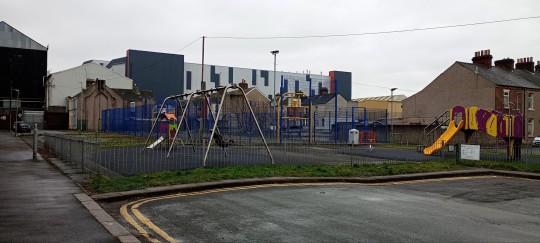
Strike knocks at the Brockbank house but gets no reply, and Robin takes a picture of some nearby workmen, thinking one of them might be Noel. This brings the police to them and they are warned to take no more photos. No-one arrived to arrest me, even though I was loitering for a good twenty minutes snapping pictures like David Bailey. Either security is too lax or they've stopped making submarines and the whole place has been secretly converted to manufacturing Weetabix.

A helpful neighbour tips them off that Holly Brockbank, not Noel, lives at the address they have. Holly works at a bakery in Vickerstown "just up the road from Vengence Street" and drinks in The Crow's Nest pub a few yards away.
Strike and Robin travel to Holly's workplace, so must go over Jubilee Bridge, formerly plain old Walney Bridge but renamed in 1935 for the silver jubilee of George V. It spans "the estuary, where sailing boats bobbed on dirty-looking water or sat marooned on mudflats."



Also there's what looks like a mystery cylindrical buidling, and since TRG all mystery cylindrical buildings have to be investigated. (I don't make the rules, OK?) Can confirm it's part of the Methodist Church and it's square. So that's OK then.
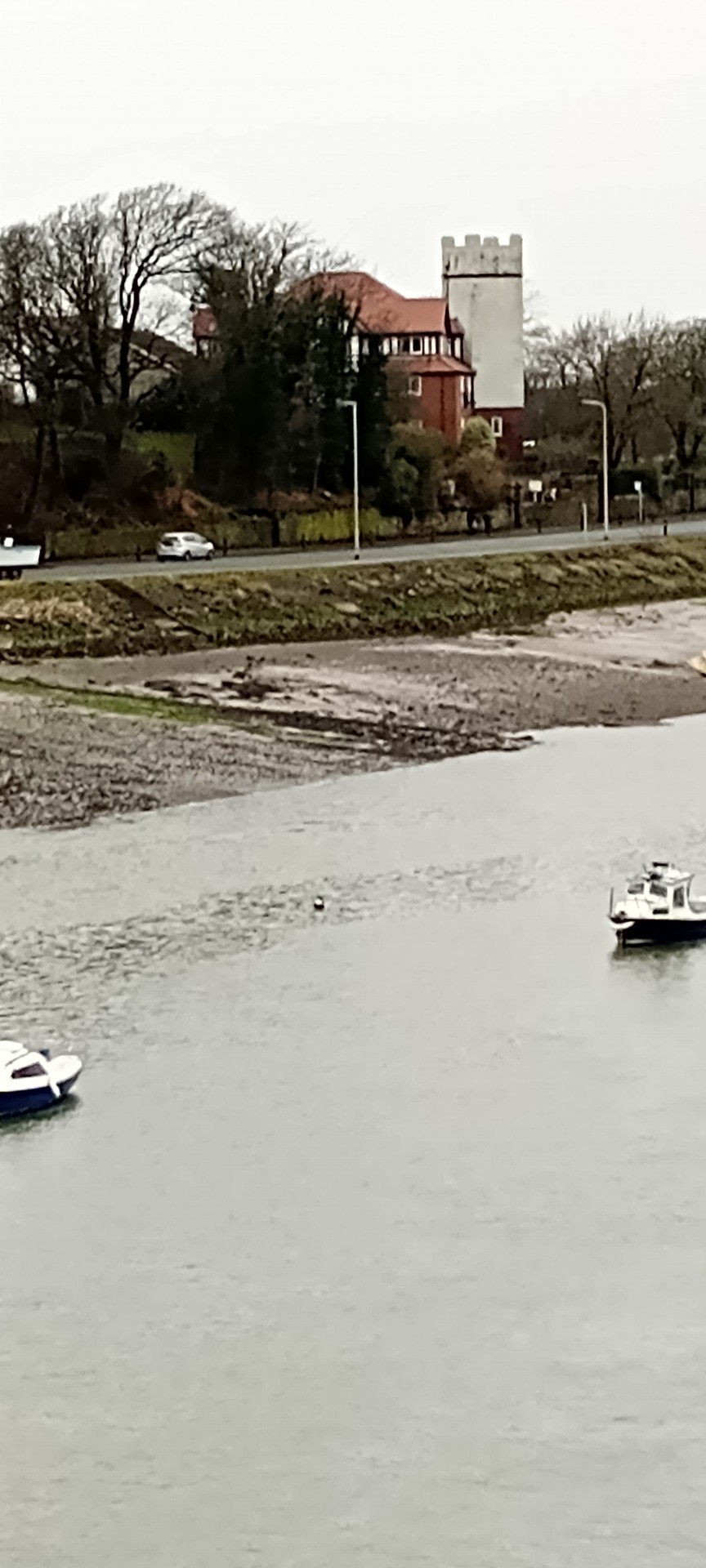
Strike, initially surprised that there's a "Vengeance Street" guesses (as they drive along Amphitrite Street) that the road names refer to the names of ships. According to Wikipedia, there have been seven HMS Amphitrites (including a cruiser launched in 1898 in Barrow) and eight HMS Vengeances (including a nuclear submarine built in Barrow and launched in 1998). I also saw a Euryalus Street and there's a Barrow-built ship of that name, so I think the road names are locally built ships.


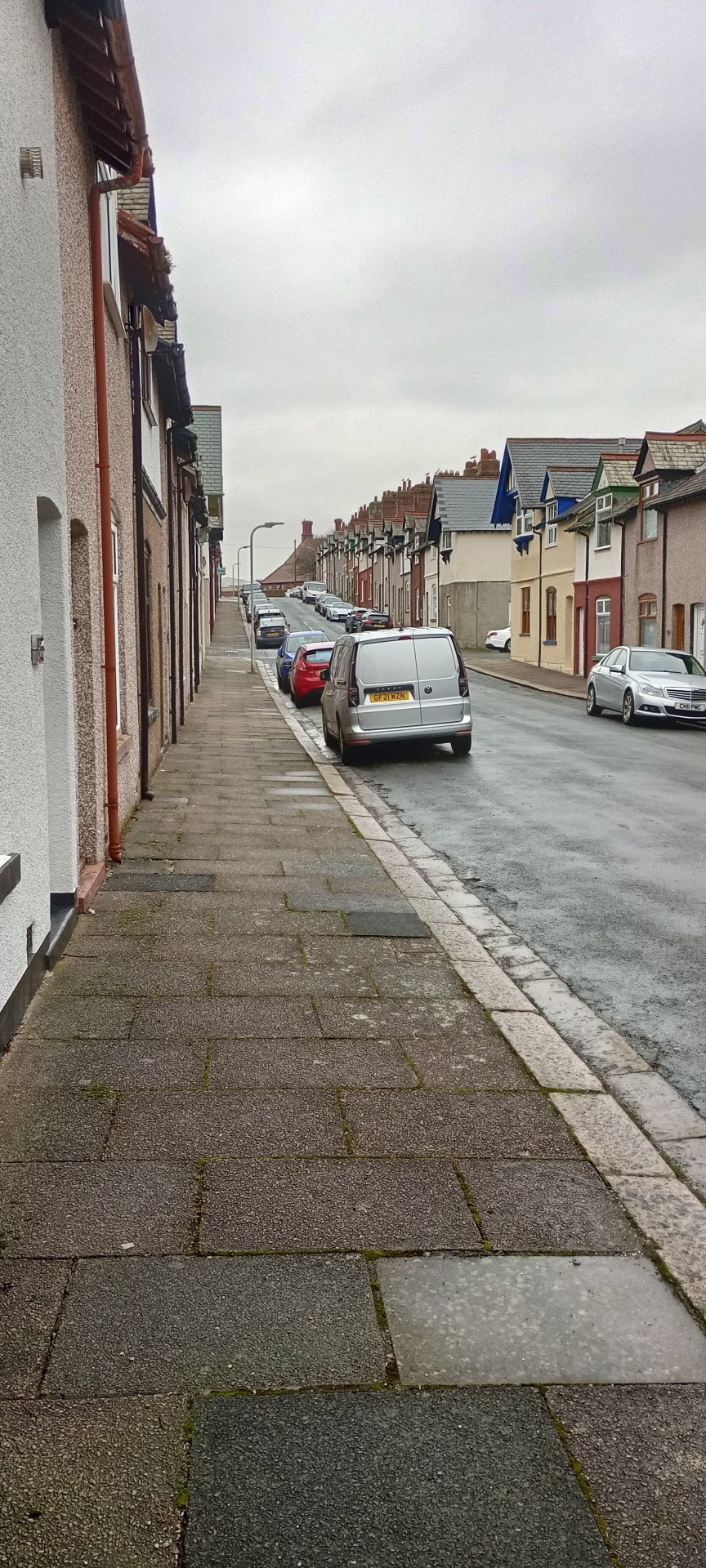
"Vengence Street ran up a hill" (and indeed it runs down the other side) and a good hundred yards or so away from the end of it Strike and Robin find "a little, white painted bakery". It was in this building, now pebble-dashed and a beauty salon called "Beautique".

End of Part 4
Go to Part 5:
Go back to the start:
5 notes
·
View notes
Note
You’ve said that Matty is becoming a silver dragon, right? What are Mattys views on cold weather and being cold in general?
honestly, before being cursed he didn’t really mind the cold. he grew up in a place that experiences all four seasons and different types of weather. and then again, he usually travels back home in the winter, so he really isn’t out in the elements during the worst type of weather the cold can bring. now that he literally CANT feel cold, it’s not that weird to him or like…worrisome. he knows its due to the curse. he’s too emotionally removed to really give it a second thought other than, “huh, guess this is what’s happening now”. like it’s so bad he had to convince the rest of the party he WASNT dying of hypothermia and was fine walking through snowy mountains in just the thin shirt he usually wears.
3 notes
·
View notes
Text

current state of my brain rn
#ramble in furness#brain please I have other things I wanna draw kajhgkja#BUT YES I HAVE BEEN THINKING ABOUT THEM A LOT#brain: make it a comic#me: but i'm already working on-#brain: did i fucking stutter#my coppernob is a girl who is known as the grouchy old station mama#even edward at 100 and whatever it is now still refers to her as mama or mama coppernob when speaking to her#i wonder how much of the barrow blitz you could see from sodor
4 notes
·
View notes
Text

HMS Agamemnon BAE Submarines Barrow-In-Furness 2024
HMS Agamemnon is the sixth of the Astute Class nuclear-powered fleet submarines. Together with her sister vessels, she will be one of the most advanced submarines ever constructed.
0 notes
